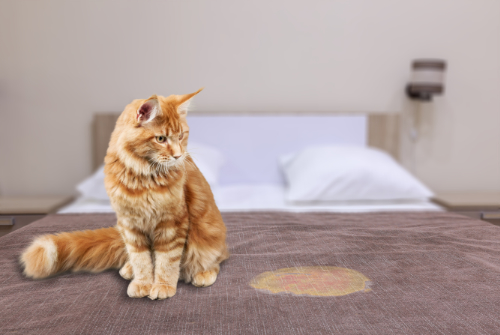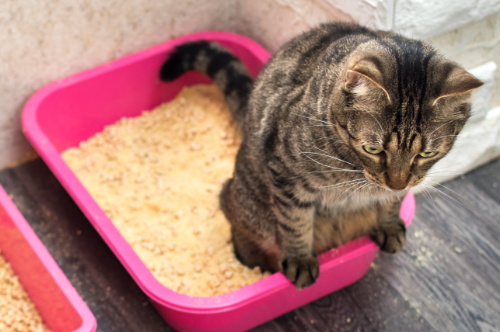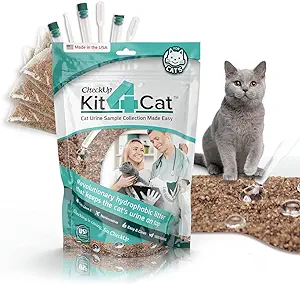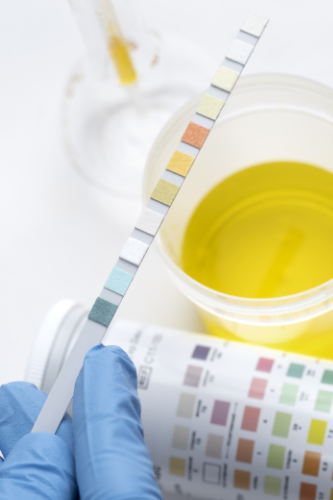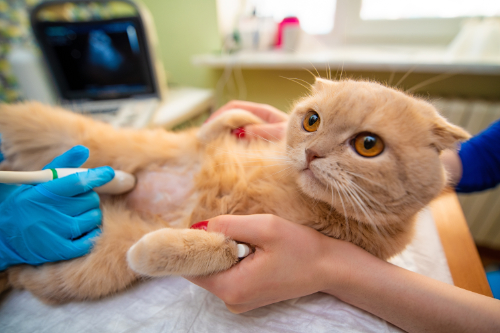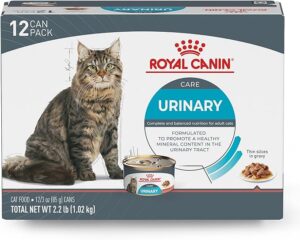Bloody urine in your female cat
What to do?
You have noticed bloody urine in your female cat. And now you’re worried about it. That is somewhat justified, because the blood is not just there for no reason. But we can reassure you a little bit. In cats, blood in the urine is rarely life-threatening. But it is very annoying for your cat! In this article we discuss the possible causes, what kind of symptoms you can see when your cat has bloody urine and, most importantly, what you as the owner can do to solve the cause of the blood in your cat’s urine. Do you have a tomcat that pees blood? Then you should be on the page about tomcats that urinate blood.
Explanation of the urinary system in a female cat
- The urine is made in the kidneys. The kidneys are filters of the blood and therefore very well supplied with many blood vessels. The urine produced will flow through the ureters to your cat’s bladder. It is stored there until there is enough to go pee. At that moment, the urine will leave your cat’s body via the urethra from the bladder. In this way, a lot of waste products are removed from your cat’s body. If blood is visible in your cat’s urine, the blood may have originated in the kidneys, ureters, bladder or urethra.
Is blood in your cat’s urine dangerous?
The fact that there is blood in your cat’s urine can’t in itself cause much harm. But the cause of this blood can of course have a serious origin. As we wrote at the beginning of this article, blood in the urine is rarely life-threatening. The chance is therefore very small that your cat will die from it. But It is important to find out what the cause is. This way you can apply the most appropriate treatment for your cat and its bloody urine will disappear again. After all, if your cat continues to lose blood through her urine for months, she may eventually develop significant anemia. Not to mention the possible pain she is in.
What does bloody urine in your cat mean?
We can distinguish between two groups here. One group is the most common and involves damage or inflammation in the tissues of your cat’s urinary tract. However, it is also possible that your cat has a problem with her blood clotting. That is the second group. This can happen, for example, if your cat has ingested rat poison. In the vast majority of cases it concerns the first group, when your cat urinates blood. However, if your cat has a blood clotting disorder, you will also see small red spots on her gums or tongue in her mouth. Or on her stomach, where there is little hair. If you see this, it is imperative that you take your cat to your vet for treatment. Unfortunately, you cannot treat this yourself.
Causes bloody urine in a cat
In most cases the problem is in the urinary tract. The cause of your cat’s bloody urine may be in the kidneys, ureters, bladder or urethra. Each of those parts may have an inflammation, infection, injury or there is a poison in your cat. Cancer is also a possible cause in older cats. In the vast majority of cases, there is a cystitis when a cat has bloody urine. Cats are very sensitive to this. All other causes occur occasionally in cats and are certainly not rare. But a cystitis is the most common cause of bloody urine in your cat.
Symptoms that you can see in your cat, besides bloody urine
- If your cat has a cystitis, she will often feel like she has to urinate. The reason for this is quite simple. The nerve endings that normally sense that the bladder wall is tense when the bladder is full have now become somewhat inflamed. This causes them to send a signal to the brain, which then thinks that there is a full bladder. And it needs to be emptied. Your cat will often try to pee.
- Pain when urinating also occurs. After all, the bladder wall is heavily inflamed and therefore sensitive. This manifests itself in plaintive meowing while urinating.
- Your cat may also urinate outside her litter box. They often prefer to choose soft things. For example, on your bed or on clothes lying around.
- They continue to strain, while only a few drops come out.
- Excessive licking of the vulva or lower abdomen. It irritates them in that area and by grooming it they reduce the pain they experience.
- Not being fit at all and wanting to eat poorly. This is caused by inflammation releasing substances in the body that can suppress appetite and ensure that your cat takes rest so that healing can occur.
What to do if there is bloody urine in your cat?
If your cat is urinating blood, it is important to try to find out what the cause is. In most cases there is a cystitis. The first step is to have a urine test carried out on your cat. It is also wise to check her entire body for signs that she may have been hit by a car. For example, check for wounds on her skin, torn nail tips, and look carefully in her mouth to see if there are any abnormalities such as hematoma’s or broken teeth. Below is further explained how you can perform a urine test on your cat if you wish.
When should you go to your vet if there is bloody urine in your cat?
If you are very concerned about your cat urinating blood, or if she appears very sick, it is wise to take her to your vet. Better safe than sorry. Your vet can physically examine her and, if possible, perform a urine test. In that case try to take some of the bloody urine that she has urinated outside the litter box with a pipette or syringe so that your vet can examine it. In some cases it is possible for your vet to take some urine out of her bladder with a needle and then aspirate the bloody urine from it. But in most cases, your cat will have an empty bladder because she keeps trying to urinate. It is not possible in that case.
Your vet can examine your cat’s bloody urine to see if she has a cystitis, but in most cases he or she will also look for urinary crystals. Unfortunately, that is something you cannot do yourself at home. But then your vet must have been able to obtain urine from your cat.
Do it yourself cat-urine test
If your cat does not appear seriously ill, you can also perform a urine test on your cat yourself. To do this you need to collect her bloody urine. It is preferable to do a urine test on your cat yourself because it is much cheaper and it also causes much less stress for your cat. The disadvantage, however, is that you have no experience with doing a urine test. It may therefore prove to be a bit (too) difficult for some people.
How to collect cat urine?
Use hydrophobic cat litter
If your cat still occasionally urinates in the litter box and urinates her bloody urine, you can use the special cat litter like we show below. If she no longer pees in the litter box, we still advise you to buy the litter. The granules also include a pipette to take up the bloody urine and a tube to store the urine in.
Isolate your cat
You ensure that your cat can’t go outside and you also ensure that no other cats can urinate in the litter box. People who have multiple cats often put the cat that urinates blood separately in the bathroom with its own litter box filled with the special stuff. As soon as your cat has urinated, you can take the bloody urine from the special litter with the supplied pipette. The litter does not absorb moisture and only give your cat the idea that the litter box is not empty. It is best if you have been able to obtain at least 1ml of bloody urine. Sometimes your cat has to go to the litter box several times to pee.
Ready to test
You can now examine the bloody urine in the urethra using a urine test strip. The one below is one of the best urinary test strips there is. But, however, you will have a lot of strips and that is really not necessary if your cat occasionally has a cystitis. But most of the time it is still cheaper to buy the teststrips than one veterinary visit.
Why do a urine test if there is bloody urine in your cat?
That’s actually useful to know, yes! The reason you need to do this is to determine whether there is a cystitis and, if so, whether there may be a bacterial cystitis. In most cases this is not the case with cats. If your cat does have a bacterial cystitis, it is necessary to give your cat a course of antibiotics. It is safest to get one course of antibiotics from your vet. In addition, you can also rule out whether diabetes may be an underlying cause for a cystitis if your cat is older. It is therefore wise to keep the tube with bloody urine while you are doing the test. In the worst case, you can still hand the remaining collected bloody urine to your vet so that the urine test can be repeated there. Otherwise they won’t give a course of antibiotics.
How do you perform the urine test yourself?
You open the container with the bloody urine from your cat. Immerse the strip completely in it and remove it immediately out of the bloody urine. All surfaces should now be a little “wet”. Close the container with the bloody urine again and keep it for a while. You should shake the strip a little above the sink so that the excess urine falls off. Then you wait 30 seconds. You can then compare the colored strips with the supplied “normal values”. Tip: take a photo of the strip next to the normal values. Then you can view the results at ease. Because after a minute or so the strip will start to discolour and then you may make an incorrect diagnosis.
If your cat has a lot of blood in her urine, it can sometimes be difficult to read the strips properly. Try to take into account a red-brown discoloration of the strips due to the blood. Are you not doing well? Then take the container with the bloody urine to your vet. They can repeat the urine test for you and give you a good diagnosis.
How do I know if my cat has a cystitis?
Explanation of the possible results of the test
If there is a cystitis, the urine values of your cat will be abnormal compared to normal. But what is normal? Fortunately, the test strips come with the normal values written on the container of the strips.
- For example, normal urine from a cat should have a pH lower than 7.
- There should be no glucose or ketones in it. Then your cat would have diabetes.
- The leukocytes should not be there either, but in cats they are very often false positive. So you shouldn’t attach too much importance to that if it turns completely purple.
- When bacteria are in the bloody urine, they produce the substance nitrite. If there is nitrite in the urine, then there is a bacterial cystitis.
- Proteins also do not belong in normal urine. These occur in urine when there is damage to the tissues of the urinary tract.
- Erythrocytes are another word for red blood cells. Since you have already seen with the naked eye that your cat is urinating blood, this strip is most likely bright green on your cat, but of course there should be no blood in the urine.
Diagnosis about cystitis
So if there is a cystitis, you will see a pH of 8 or higher, and there are leucocytes, proteins and blood in the urine. If the nitrite is increased, this indicates a bacterial cystitis. And if you see that glucose or ketones are present in the bloody urine, this indicates diabetes. In the last two cases you should contact your vet.
Your cat has bloody urine due to stress
Number 1 cause of a cystitis in female cats
About 69% of cats with a cystitis got it because they experienced stress. As a result of stress, your cat’s immune system has become weaker, which can easily upset her bladder wall and cause a cystitis. In many cases, an owner does not have the idea that their cat is stressed. Cats show this very poorly to their owners. Or actually, we humans are just very bad at recognizing stress signals from our cats.
Treating stress
Many articles have now been written about how to best reduce stress in cats. Make sure your cat has its own litter box and doesn’t have to share it with another cat. The same goes for a place to eat. Don’t let them eat next to each other unless they are close friends. I wouldn’t want to sit down to eat with my enemy either. And it is also wise to offer your cat many extra places to sleep that are at a considerable distance from the other cats in the house. For example, create extra places to lie on shelves on the wall.
You can treat stress in cats by using Zylkène tablets. These are tablets with natural ingredients that are the precursor to serotonin. By giving these substances to your cat, you ensure that your cat can make serotonin more easily. This will make her feel more relaxed and have more self-confidence. The result is that she experiences less stress.
Don’t feel like giving tablets to your cat? Then you can also give your cat the Calm diet from Royal Canin. It contains more or less the same substances as in Zylkène. The packaging also states “S/O index”. This means that your cat will not ingest any substances with her food that will cause her to develop urinary crystals. You can read more about this cause below.
Your old cat has bloody urine
If you have an older cat of 10 years and older, the chance of underlying problems is considerably greater than with cats younger than 10 years old. In that case, we recommend that you take your senior cat to your vet to have her examined further. Especially if her cystitis keeps coming back with some regularity. An ultrasound is probably the way to go.
Your cat has bloody urine due to urine crystals
About urine crystals
The second major cause of a cystitis in a cat is urinary crystals. These are microscopic crystals that form in the urine as a result of certain substances that were included in your cat’s food. The cheaper the food, the bigger the chance that these substances were incorporated into it. You can imagine urinary crystals as being in the form of sugar crystals, but in the bloody urine. If you keep rubbing sugar on your arm, your skin will eventually break. The same happens due to the urine crystals on the inside of the bladder. The result is that the bladder wall becomes inflamed, causing blood, proteins and immune cells to appear in the urine.
These crystals can also join together to form a urinary stone. There is then a hard mass in her bladder where urine should be. Your vet can feel the larger stones by hand. The smaller ones can be determined with a bladder ultrasound or X-ray.
Diagnose urine crystals
Unfortunately, you can’t detect urinary crystals yourself with a urine test. If you want to know for sure, you can take the collected urine from your cat to your vet and ask them to test it for urinary crystals. This test must be carried out within 4 hours after urinating the bloody urine, as crystals may naturally form in the bloody urine after that time. In that case you might get a false positive result.
You can instead give your cat a diet that resolves urinary crystals, even if you are unsure that urinary crystals are present. In that case, Royal Canin Urinary S/O is suitable. However, if you are not sure, it is preferable to give the Calm Diet we showed befor. It is also against urinary crystals, but also reduces stress. In that case you treat both causes.
Your cat has a bloody urine due to a bacterial infection
If the nitrite is increased in the urine test, it is most likely a bacterial cystitis. This is only the case in 5% of cats with a cystitis. In other words, only 1 in 20 cats with a cystitis has a bacterial cystitis. However, these cats do require a course of antibiotics. So does your cat have nitrite in her urine? Then you will have to take your cat and the container with her bloody urine to your vet. He or she can then prescribe a course of antibiotics to your cat.
Your cat has bloody urine after a collision or other accident
We quite often see a cat urinating blood for a day after being hit by a car. In that case, there is bruising and damage to her kidney(s), bladder or urinary tract. In most cases you can tell that a cat has been hit by a car by looking at its nails. If the tips of her nails are frayed, she has braced herself to absorb the blow. If she otherwise behaves normally, you can wait for a day. But if in doubt, it is best to go to your vet. After all, other forms of internal bleeding may also have occurred. She could bleed to death from this.
Your cat has bloody urine due to a polyp or tumor
In older cats, polyps can develop in the bladder. These are sort of mushroom-like shapes that grow from the surface somewhere in her body. In this case, from the surface of her bladder or urinary tract. A cystitis will develop, but this cannot be resolved (permanently) with nutrition and stress treatments. Unfortunately, a polyp in the bladder very often turns into cancer. Such a polyp can be diagnosed using an ultrasound or a bladder scan (camera in the bladder) and in some cases it is possible to remove this polyp surgically.
Your cat has bloody urine due to a kidney problem
Especially in the case of acute renal failure, it is possible that the kidneys become so bad that the blood cells no longer remain in the blood vessels. In that case there is a loss from the normal blood circulation into the urinary tract. It goes without saying that this is a very serious problem. Your cat is visibly very ill and is behaving anything but normal. She doesn’t want to eat and will probably throw up too. This is a reason to take her to your vet.
Your cat has bloody urine due to poisoning
Earlier we talked about rat poison as a cause for bloody urine. This can cause your cat to develop blood clotting disorders and subsequently experience bleeding in her body, including in her bladder. However, your cat could also have licked ethylene glycol, better known as antifreeze. As a result, acute kidney failure can develop, which in turn causes blood to appear in her urine. Fortunately, we see this very rarely.
Can a cystitis in a cat heal on its own?
That is certainly possible and we often see it in the veterinary practice. Cats that suffer from stress can sometimes get a cystitis. Once the stress has subsided, your cat will resolve her cystitis automatically. The blood peeing is then over. And in fact, it is also possible that you have given your cat the wrong food, causing her to develop urinary crystals and therefore a cystitis. You then switched to a different diet that did not cause her to form urinary cristals. Then the problem also solves itself.
Only a bacterial cystitis does not resolve itself. And cystitis caused by polyps do not resolve themselves or keep coming back.
These crystals can also join together to form a real bladder stone. There is then a hard mass in her bladder where urine should be. Your vet can feel the larger stones with his hand. The smaller ones can be determined with a bladder ultrasound or X-ray.
What can you do yourself if there is bloody urine in your cat?
Adjust nutrition
If your cat urinates blood, it is important that you do a urine test to diagnose a cystitis. Is there a cystitis? In that case, it is wise to put your cat on the Calm diet from Royal Canin because it reduces stress and also dissolves urinary crystals. In that case, you are already treating 91% of all cats with a cystitis correctly.
Anti-inflammatory and analgesic medications
To make your cat experience less pain from the cystitis, you can also give her a half of a tablet of Aspirin 81mg once every 2 days. ONLY ASPIRIN!!! All other types of human painkillers are fatal for your cat!! However, it is preferable to give your cat a painkiller that you can pick up from your vet. Officially, your vet may only provide this if he or she has examined your cat. But occasionally a veterinarian may want to make an exception.
Alternative analgesic and anti-inflammatory medications
You can also use Hemp oil to reduce stress in your cat and treat inflammation. It is wise to give this together with the Calm diet. CBD oil alone is rarely sufficient to treat cystitis in your cat.
Have plenty of water to drink
It is also wise to let your cat drink as much water as possible so that she urinates more. This way, she will pass out more of the irritating substances in her urine so that they can no longer irritate the bladder wall. You can read more about how to get your cat to drink more later in this article.
What does your vet do if there is a bloody urine in your cat?
How much does a urine test for a cat cost at your veterinarian?
Veterinarians may determine their own prices, including the price of a urine test. In most cases the price is somewhere around €50. If you want to know the exact price, you can always call or email your vet and ask them what the costs are.
How do you stimulate your cat to make more urine?
To prevent a cystitis, it is wise to let your cat drink more water. The result is that she will also urinate more and therefore clear her bladder more often of substances that irritate her bladder.
You can of course start by putting some water over your cat’s kibble and see if she wants to eat it. However, don’t leave it for too long, because then it won’t be any tastier for your cat.
You can also give a cat more wet food in her diet. Meat contains much more moisture than kibble. Unfortunately, Royal Canin Calm does not have wet food. But you can give your cat urinary meat in addition to the Calm diet.
It is also wise to offer your cat a water fountain. Most cats like to drink from running water and will drink more from a fountain than from a regular bowl.
You will never be able to prevent it completely. But by letting your cat drink a lot, giving your cat high-quality food and reduce stress as much as possible, you provide a very good basis. If your cat is very sensitive to cystitis, you can also give your cat nutritional supplements to improve the immune system in her urinary tract.
Hopefully you will soon no longer see bloody urine from your cat and will the cystitis have been resolved for the rest of her life! Good luck!



